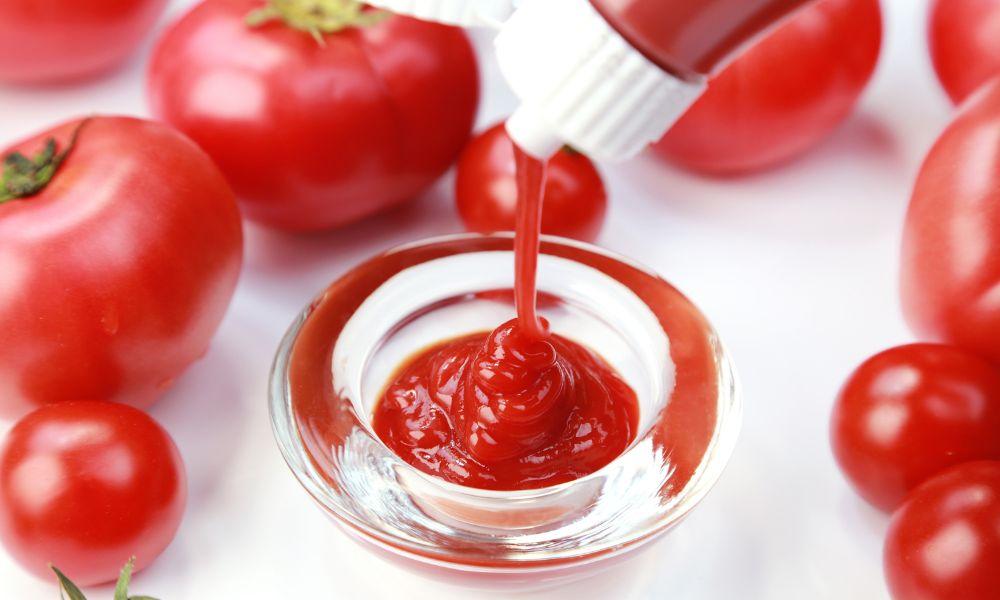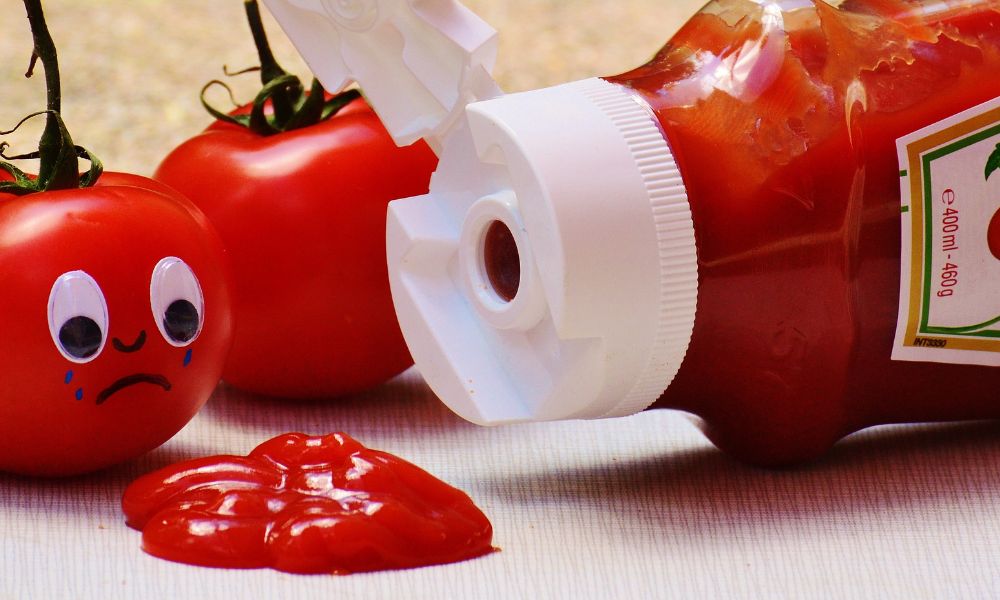Ketchup – a favorite condiment for many where the red tangy sauce brings life to sandwiches, burgers, and many other dishes. But have you ever thought what lies beyond the realms of classic Tomato Ketchup? Imagine an intriguing flavor twist transforming your ordinary meal into a tropical delight. Welcome to the world of Banana Ketchup!
Join me, John Bird, a seasoned culinary enthusiast with extensive knowledge and experience in the food industry, as we dive into the adventurous journey of these two unique ketchups, exploring their origins, taste profiles, nutritional aspects, and culinary roles across the globe. Let’s embark on this saucy adventure!

Discovering Banana Ketchup: The Origin Story
Let me assure you, as bewildering as it may sound, banana ketchup is as real as the springy dough of a New York pizza. This intriguing, unanticipated, yet totally appetizing condiment sprouted from the tropical land of the Philippines where bananas grow in abundant clusters, much like the city’s high-rises. Its inception is a testament to brilliance sparked from the most challenging conditions.
Around the time of World War II, tomatoes, a customary base for ketchup, became a rare sight in the Philippine markets, almost akin to spotting a calm New Yorker during rush hour. However, bananas were plentiful, as ubiquitous as the yellow cabs on Manhattan streets. This challenge of scarcity led to an ingenious substitution of tomatoes with bananas for the beloved ketchup. The result? A succulent sauce with a splash of tropical sweetness, perfectly marrying the rich, savory undertones of Filipino cuisine. It was love at first bite for the Filipinos, and very soon, it was the “Big Apple” of every Filipino table.
The Age-Old Debate: Banana Ketchup vs. Tomato Ketchup?
| Criteria | Banana Ketchup | Tomato Ketchup |
|---|---|---|
| Origin | Originated in the Philippines during World War II due to a scarcity of tomatoes. | Originated in North America, now consumed worldwide. |
| Commonly used in | Filipino cuisine | Global Cuisine |
| Taste | Sweeter, subtler, and fruitier, with less evident tanginess. | Sweet, tangy, and savory blend with a slight acidic punch. |
| Nutritional Benefits | Rich in potassium and dietary fiber; has probiotic aspects due to vinegar. | Contains lycopene, a powerful antioxidant. Consumed in moderation due to higher sugar content. |
| Famous Brand | Jufran | Heinz |
| Where to Buy | Commonly available online and regions with significant Filipino diaspora. | Available worldwide, both online and offline. |
| Popular Dishes | Traditions Filipino spring rolls, BBQ meats, Rice dishes, fries. | Burgers, Sandwiches, Fries, BBQ and grilled meats, pizzas, pastas. |
| Unique Aspects | Unique tropical taste, healthier sugar levels. | Versatile culinary applications due to its tangy flavor profile. |
Taste – the grand arena where the true battle between banana ketchup and tomato ketchup unfolds. But how can one put these contrasting symphonies of flavor into words?
As bonafide culinary enthusiasts, most of us are no strangers to the quintessential taste of tomato ketchup—it’s a masterful blend of sweet, tangy, and savory with a slight acidic kick, courtesy of the ripe tomatoes. This harmony of flavors adds a depth to a spectrum of dishes, making tomato ketchup hold the torch as a leading condiment worldwide.
Balancing on the other scale, banana ketchup, with its sweet origin, mysteriously tastes nothing like its main ingredient. The trick lies in the additions of vinegar, sugar, and a melody of spices, all playing their part to recreate the iconic ketchup flavor. A touch of red food coloring gives it a deceptive look similar to tomato ketchup. The result is a subtly sweet, fruity condiment that accentuates the flavors of grilled meats and rice dishes, making it an indispensable element of Filipino cuisine, and a healthier ketchup option for those keeping a check on their sugar levels.
Unearthing Nutritional Gems
Health is wealth, they say, and both ketchups seem to follow that mantra, offering a good load of benefits thanks to their star ingredients.
Banana Ketchup
The most significant reason to celebrate banana ketchup extends from its content of bananas, nature’s energy-packed snack. Bananas are a rich source of potassium, essential for heart health and normal body functioning, and dietary fiber, which aids digestion. The addition of vinegar gives banana ketchup a probiotic kick, promoting gut health, making it an excellent contender for healthy recipes with banana ketchup.
Tomato Ketchup
In contrast, tomato ketchup has an ace up its sleeve, the ‘lycopene.’ This antioxidant found in red fruits and vegetables is linked to heart health and cancer prevention. However, be mindful of the quantity of tomato ketchup consumed due to its high sugar content, especially in mass-produced variants.
Importantly, both these ketchups offer something uniquely delicious, especially when used as ketchup alternatives in recipes using the Condiment Evolution knob. This culinary technique involves swapping traditional condiments to mix it up with new flavors and adventure. Imagine replacing your usual tomato ketchup with banana ketchup in your cherished family meatloaf recipe. Now, wouldn’t that make for an exotic best ketchup for burgers?
Brand Wars: Who Takes the Crown?

A silent war rages among brands worldwide to be the top choice for banana and tomato ketchup. Amid the many contenders, some brands stand out due to their exceptional taste and quality ingredients.
Banana ketchup lovers continue to be fond of “Jufran“, a Filipino brand famous for its authentic taste. The name “Jufran” is a blend of “Junior and Fran”, a tribute from the owner of the company to his grandchildren. The banana ketchup from Jufran is a delight to the palate, offering a fruity, tangy kick, making it an excellent accompaniment to traditional Filipino spring rolls and even French fries for the gastronomically adventurous.
Speaking of tomato ketchup, “Heinz“, the longstanding champion, often tops the chart. Known for its balanced sweetness and acidity, Heinz has been setting standards in the world of tomato ketchup since 1876, making it a trusted choice.
While locally-stocked grocery stores and supermarkets hold these popular ketchup brands, it’s the online platforms that extend the reach to the far corners of the world, offering a cornucopia of affordable banana ketchup brands.
In the pursuit of choosing good quality ketchup, an examination of the ingredients list is key. Opt for variants with minimal chemical additives, low sugar, and natural ingredients for the healthiest and most flavorful choices.
Global Influence and The Rise in Popularity
From the local Filipino markets to the streets of bustling cities like New York, the reach of banana ketchup has undeniably broadened over the years. On a global scale, this unique condiment has managed to claim its space in parts of the United States, especially in areas housed with a significant Filipino diaspora, as well as diverse corners of Asia.
Strolling along the usual path, the tomato ketchup continues to hold its ground as an essential item, whether it’s a buzzing fast-food chain, cozy school cafeterias, sunny picnic spots, or our very own dinner tables. In essence, any meal where a zingy tang is desired, it’s the tomato ketchup that people often reach out for. Plus, its versatile culinary applications further solidify its global standing.
However, the challenger, the banana ketchup, emerges as a notable alternative for gourmets and food adventurers looking to lend a tropical twist to their meals. Who needs a ticket to a beach holiday when you can introduce a tropical flair right on your plate, right? Just imagine upgrading your usual sandwiches, enriching the flavor profile of your barbecued meats, or leaving a sweet surprise in your classic egg and toast breakfast by squeezing in some banana ketchup. As you experience this intriguing blend, you become a part of a growing global flavor culture.
Final Take: Which Ketchup Rules Your Plate?
The decision between banana and tomato ketchup essentially boils down to one’s personal preference and culinary needs. Let’s not treat this as a race, rather as a celebration of how food evolves with changing circumstances, locations, and available resources.
Further exploring the nutritional value of Tomato vs Banana ketchup, the unique flavor profiles each one introduces, their fascinating history, and the growing global influence, paints a wholesome picture of their significance in culinary adventures.
Whether your loyalties lie with Banana Ketchup or if you’re a die-hard fan of the traditional Tomato Ketchup, embarking on the exploration of these intriguing condiments promises to be a playful culinary experiment, and that’s what food should ultimately be – a fun experiment. How about trying them both, diving deep into homemade ketchup recipes, substituting Tomato ketchup with Banana ketchup in your favorite dishes, and discovering your own ketchup taste difference? Let your taste buds make the judgement!
FAQs
What is the difference between banana ketchup and tomato ketchup in terms of taste?
Tomato Ketchup offers a sweet, tangy, and savory blend with a slight acidic punch. Banana Ketchup, on the other hand, brings a subtly sweet, fruity flavor on the table with less evident tanginess.
What are the nutritional differences between banana ketchup and tomato ketchup?
Banana Ketchup is rich in potassium and dietary fiber derived from bananas. Tomato Ketchup is known for its heart-healthy lycopene content.
Is it possible to substitute tomato ketchup with banana ketchup?
Absolutely! Swapping Tomato Ketchup with Banana ketchup in your recipes can offer a fresh and unique flavor profile to enjoy!
Where can I find affordable banana ketchup brands?
Online platforms offer a variety of Banana Ketchup brands at affordable prices. Try to opt for brands that come with natural ingredients and have lower sugar content.
References:
Be adventurous, sit back, and indulge in the world of ketchups. Let your culinary exploration be filled with delightful flavors of these unique yet equally mesmerizing condiments. Bon appétit!






